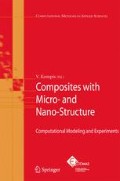Abstract
A predictive model has been developed to determine the biaxial stress-strain response of architectural fabrics, without the need for biaxial testing. Sawtooth and sinusoid models of the fabric unit cell have been formulated, with spring elements between crossovers used to represent the coating. In both models a constant yarn cross-sectional area has been maintained, resulting in a relationship between unit cell length and yarn thickness which eliminates the need to determine the yarn crushing stiffness. A state-of-the-art biaxial test rig and new test protocol have been developed to fully ascertain the stress-strain behaviour of structural fabrics. This enables meaningful comparison to be made between the model output and actual fabric response. The model provides a more accurate representation of fabric behaviour than current industry best practice (i.e. use of elastic constants based on biaxial test data), but without the need for specialist testing or equipment.
Access this chapter
Tax calculation will be finalised at checkout
Purchases are for personal use only
Preview
Unable to display preview. Download preview PDF.
References
Bridgens BN, Gosling PD, Birchall MJS (2004) Membrane material behaviour: Concepts, practice & developments. The Structural Engineer 82(14):28–33.
Bridgens BN, Gosling PD (2004) A new biaxial test protocol for architectural fabrics. In Motro R (ed), IASS 2004 Symposium Montpellier: Shell and Spatial Structures from Models to Realisation pp. 246–247.
B.S. EN ISO 1421:1998, Rubber-or plastics-coated fabrics — Determination of tensile strength and elongation at break, British Standards Institute.
Dimitrov N, Schock HJ (1986) Study on the load-extension behaviour of coated fabrics, with special reference to PTFE-coated glass-fibre, using the Meffert model. In LSA 86: Lightweight Structures in Architecture, Proceedings of the First International Conference.
Freeston WD, Platt MM, Schoppee MM (1967) Stress-strain response of fabrics under two-dimensional loading. Textile Research Journal 37:656–682.
Glaesgen EH, Pastore CM, Griffin OH, Birger A (1996) Geometrical and finite element modelling of textile composites. Composites, Part B 27(1):43–50.
Kato S, Minami H, Yoshino T, Namita T (1997) Analysis of membrane structures based on fabric lattice model considering viscous characteristics. In Proceedings of the IASS International Symposium on Shell and Spatial Structures, Singapore, pp. 411–420.
Menges G, Meffert B (1976) Mechanical behaviour of PVC coated polyester fabrics under biaxial stress. Journal of Kunststoffe German Plastics 66(11):12–14.
Olofsson B (1964) A general model of a fabric as a geometric-mechanical structure. Journal of the Textile Institute 55:T541–T557.
Pargana JB, Lloyd Smith D, Izzuddin BA, (2000) Advanced material model for the analysis of tensioned fabric structures. In Computational Methods for Shell and Spatial Structures, IASS-IACM 2000, Chania, Crete, Greece.
Peirce FT (1937) The geometry of cloth structure. Journal of the Textile Institute 28:81–88.
Sasai T, Kawabata S (1985) Biaxial tensile properties of textured yarn fabrics. Journal of the Textile Machinery Society of Japan 31(2):29–34.
Tarfaoui M, Akesbi S (2001) A finite element model of mechanical properties of plain weave. Colloids and Surfaces A: Physicochemical and Engineering Aspects 187/188:439–448.
Testa RB, Stubbs N, Spillers WR (1978) Bilinear model for coated square fabrics. Journal of Engineering Mechanics 104:1027–1042.
Wang F (2002) Prediction method for tensile property of woven fabrics in lower loads. Journal of Dong Hua University (English edition) 19(2):6–14.
Author information
Authors and Affiliations
Editor information
Editors and Affiliations
Rights and permissions
Copyright information
© 2008 Springer
About this chapter
Cite this chapter
Bridgens, B.N., Gosling, P.D. (2008). A Predictive Fabric Model for Membrane Structure Design. In: Oñate, E., Kröplin, B. (eds) Textile Composites and Inflatable Structures II. Computational Methods in Applied Sciences, vol 8. Springer, Dordrecht. https://doi.org/10.1007/978-1-4020-6856-0_3
Download citation
DOI: https://doi.org/10.1007/978-1-4020-6856-0_3
Publisher Name: Springer, Dordrecht
Print ISBN: 978-1-4020-6855-3
Online ISBN: 978-1-4020-6856-0
eBook Packages: EngineeringEngineering (R0)

